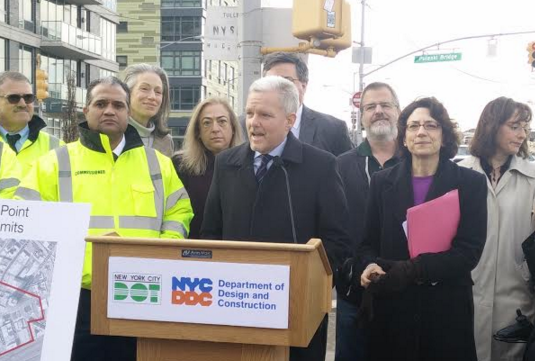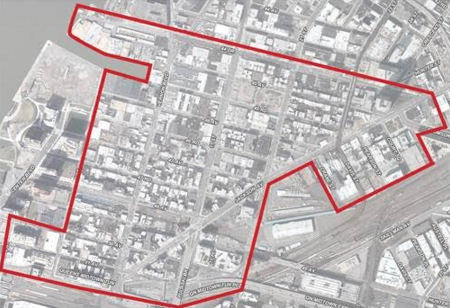
The streets of Long Island City are getting a total rebuild, and as part of the project four major intersections along Jackson Avenue and Vernon Boulevard will get redesigned for greater safety.
Many other intersections could get curb extensions or other traffic-calming treatments as part of the $38.47 million neighborhood-wide street reconstruction. Speaking this morning at the foot of the Pulaski Bridge, Council Member Jimmy Van Bramer said DOT will prioritize four intersections: 21st Street and Jackson Avenue, 23rd Street and Jackson Avenue, Vernon Boulevard and Jackson Avenue, and Vernon Boulevard and 44th Drive.
Jackson and 11th Street, a complex multi-leg intersection that pedestrians and cyclists have to navigate to get to the Pulaski Bridge, will also be improved. Once the Pulaski Bridge bikeway opens this spring, there will be a lot more room for walking and biking, and the approach on the Queens side could use an upgrade.
Long Island City’s population is on track to soar as new development hits the market. But sandwiched by the Queensboro Bridge to the north and the Pulaski Bridge and Midtown Tunnel to the south, the neighborhood is often overrun by car and truck traffic, creating an unpleasant and unsafe environment for pedestrians.
In December, Van Bramer, DDC, and DOT hosted a public workshop where local residents and business owners overwhelmingly cited Vernon Boulevard and Jackson Avenue as streets in need of safety improvements. Jackson Avenue feeds into the Pulaski and is the site of several popular attractions, including MOMA P.S. 1, but has few safe crosswalks. In 2015 alone, 31 people were injured on Jackson Avenue within the project boundaries.

DOT Commissioner Polly Trottenberg and DDC Commissioner Feniosky Peña-Mora joined Van Bramer this morning to highlight the additional $29.6 million the city has included for the project in its 2017 budget, on top of $8.8 million in city and federal funds already earmarked. The investment marks the first major reconstruction of the area's streets since the early 20th century.
Street projects involving DDC are notorious for moving at a snail's pace, routinely falling years behind schedule.
When a reporter asked if the project would take two years, Peña-Mora laughed and said, “You haven’t been around construction, have you?”
The timeline for the project has not shifted as a result of the additional funding. DOT and DDC plan to come to Community Board 2 this month with a preliminary design, which will be completed by the summer.





